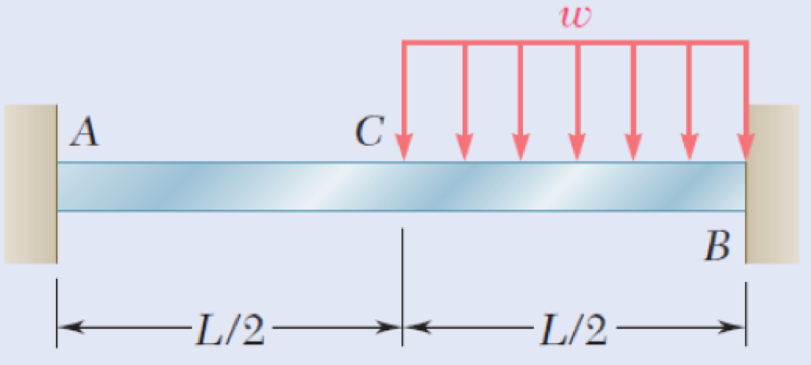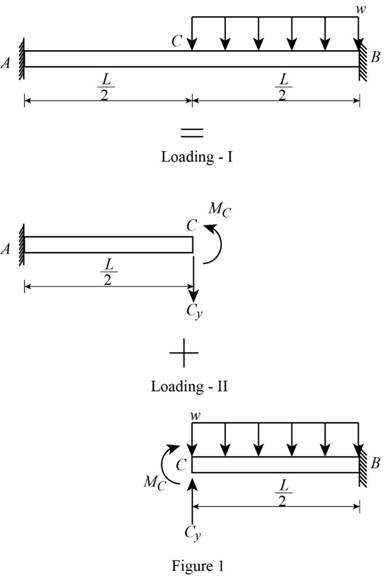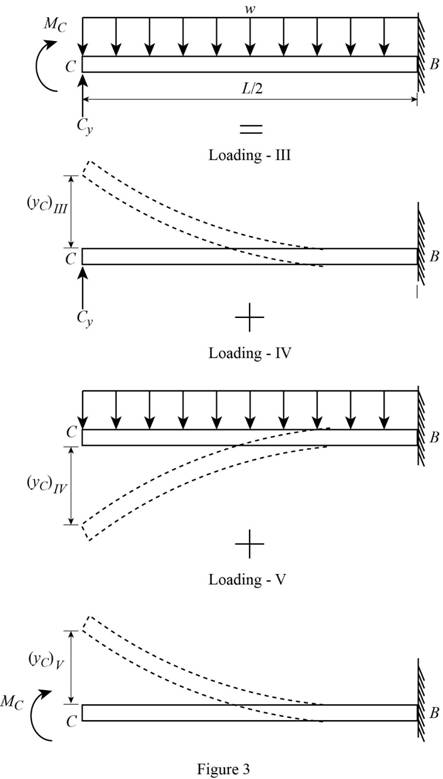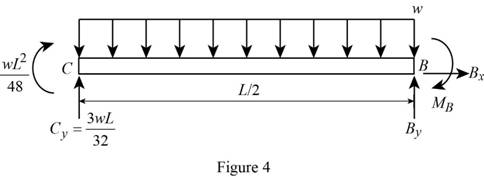
Concept explainers
Use the method of superposition to solve the following problems and assume that the flexural rigidity El of each beam is constant.
9.83 and 9.84 For the beam shown, determine the reaction at B.

Fig. P9.83
Find the reaction at point B of the beam using superposition method.
Answer to Problem 83P
The vertical reaction at point B is
The moment at point B is
Explanation of Solution
The flexural rigidity of the beam is EI.
Convert the beam into two sections as in Figure 1.

Consider portion AC of the beam:
Show the free-body diagram of the superimposed beam as in Figure 2.

Loading I:
The downward reaction
Refer to case 1 in Appendix D “Beam Deflections and Slopes” in the textbook.
Write the equation for slope and deflection for point load acting in a cantilever beam as follows;
Find the deflection at point C due to vertical reaction as follows;
Find the slope at point C due to vertical reaction as follows;
Loading II:
The counter-clockwise moment is acting at point C.
Refer to case 3 in Appendix D “Beam Deflections and Slopes” in the textbook.
Write the equation for slope and deflection for moment acting in a cantilever beam as follows;
Find the deflection at point C due to moment as follows;
Find the slope at point C due to moment as follows;
Find the deflection at point C as follows;
Substitute
Find the slope at point C as follows;
Substitute
Consider portion CB of the beam:
Show the free-body diagram of the superimposed beam as in Figure 3.

Loading III:
The upward reaction
Refer to case 1 in Appendix D “Beam Deflections and Slopes” in the textbook.
Write the equation for slope and deflection for point load acting in a cantilever beam as follows;
Find the deflection at point C due to vertical reaction as follows;
Find the slope at point C due to vertical reaction as follows;
Loading IV:
The downward uniformly distributed load (udl) is spread throughout the portion BC.
Refer to case 2 in Appendix D “Beam Deflections and Slopes” in the textbook.
Write the equation for slope and deflection for udl spread throughout the cantilever beam as follows;
Find the deflection at point C due to udl as follows;
Find the slope at point C due to udl as follows;
Loading IV:
The clockwise moment is acting at point C.
Refer to case 3 in Appendix D “Beam Deflections and Slopes” in the textbook.
Write the equation for slope and deflection for moment acting in a cantilever beam as follows;
Find the deflection at point C due to moment as follows;
Find the slope at point C due to moment as follows;
Find the deflection at point C as follows;
Substitute
Find the slope at point C as follows;
Substitute
The resultant deflection at point C is equal.
Equate the equations (1) and (3).
The resultant slope at point C is equal.
Equate the equations (2) and (4).
Show the free-body diagram of the portion CB as in Figure 4.

Find the vertical reaction at point B by resolving the vertical component of forces.
Find the moment at point B by taking moment about point B.
Therefore,
The vertical reaction at point B is
The moment at point B is
Want to see more full solutions like this?
Chapter 9 Solutions
Mechanics of Materials, 7th Edition
- 1. The consequences of a head-on collision of two automobiles can be studied by considering the impact of the automobile on a barrier, as shown in figure below. Construct a mathematical model (i.e., draw the diagram) by considering the masses of the automobile body, engine, transmission, and suspension and the elasticity of the bumpers, radiator, sheet metal body, driveline, and engine mounts.arrow_forward3.) 15.40 – Collar B moves up at constant velocity vB = 1.5 m/s. Rod AB has length = 1.2 m. The incline is at angle = 25°. Compute an expression for the angular velocity of rod AB, ė and the velocity of end A of the rod (✓✓) as a function of v₂,1,0,0. Then compute numerical answers for ȧ & y_ with 0 = 50°.arrow_forward2.) 15.12 The assembly shown consists of the straight rod ABC which passes through and is welded to the grectangular plate DEFH. The assembly rotates about the axis AC with a constant angular velocity of 9 rad/s. Knowing that the motion when viewed from C is counterclockwise, determine the velocity and acceleration of corner F.arrow_forward
- 500 Q3: The attachment shown in Fig.3 is made of 1040 HR. The static force is 30 kN. Specify the weldment (give the pattern, electrode number, type of weld, length of weld, and leg size). Fig. 3 All dimension in mm 30 kN 100 (10 Marks)arrow_forward(read image) (answer given)arrow_forwardA cylinder and a disk are used as pulleys, as shown in the figure. Using the data given in the figure, if a body of mass m = 3 kg is released from rest after falling a height h 1.5 m, find: a) The velocity of the body. b) The angular velocity of the disk. c) The number of revolutions the cylinder has made. T₁ F Rd = 0.2 m md = 2 kg T T₂1 Rc = 0.4 m mc = 5 kg ☐ m = 3 kgarrow_forward
- (read image) (answer given)arrow_forward11-5. Compute all the dimensional changes for the steel bar when subjected to the loads shown. The proportional limit of the steel is 230 MPa. 265 kN 100 mm 600 kN 25 mm thickness X Z 600 kN 450 mm E=207×103 MPa; μ= 0.25 265 kNarrow_forwardT₁ F Rd = 0.2 m md = 2 kg T₂ Tz1 Rc = 0.4 m mc = 5 kg m = 3 kgarrow_forward
- 2. Find a basis of solutions by the Frobenius method. Try to identify the series as expansions of known functions. (x + 2)²y" + (x + 2)y' - y = 0 ; Hint: Let: z = x+2arrow_forward1. Find a power series solution in powers of x. y" - y' + x²y = 0arrow_forward3. Find a basis of solutions by the Frobenius method. Try to identify the series as expansions of known functions. 8x2y" +10xy' + (x 1)y = 0 -arrow_forward
 Elements Of ElectromagneticsMechanical EngineeringISBN:9780190698614Author:Sadiku, Matthew N. O.Publisher:Oxford University Press
Elements Of ElectromagneticsMechanical EngineeringISBN:9780190698614Author:Sadiku, Matthew N. O.Publisher:Oxford University Press Mechanics of Materials (10th Edition)Mechanical EngineeringISBN:9780134319650Author:Russell C. HibbelerPublisher:PEARSON
Mechanics of Materials (10th Edition)Mechanical EngineeringISBN:9780134319650Author:Russell C. HibbelerPublisher:PEARSON Thermodynamics: An Engineering ApproachMechanical EngineeringISBN:9781259822674Author:Yunus A. Cengel Dr., Michael A. BolesPublisher:McGraw-Hill Education
Thermodynamics: An Engineering ApproachMechanical EngineeringISBN:9781259822674Author:Yunus A. Cengel Dr., Michael A. BolesPublisher:McGraw-Hill Education Control Systems EngineeringMechanical EngineeringISBN:9781118170519Author:Norman S. NisePublisher:WILEY
Control Systems EngineeringMechanical EngineeringISBN:9781118170519Author:Norman S. NisePublisher:WILEY Mechanics of Materials (MindTap Course List)Mechanical EngineeringISBN:9781337093347Author:Barry J. Goodno, James M. GerePublisher:Cengage Learning
Mechanics of Materials (MindTap Course List)Mechanical EngineeringISBN:9781337093347Author:Barry J. Goodno, James M. GerePublisher:Cengage Learning Engineering Mechanics: StaticsMechanical EngineeringISBN:9781118807330Author:James L. Meriam, L. G. Kraige, J. N. BoltonPublisher:WILEY
Engineering Mechanics: StaticsMechanical EngineeringISBN:9781118807330Author:James L. Meriam, L. G. Kraige, J. N. BoltonPublisher:WILEY





